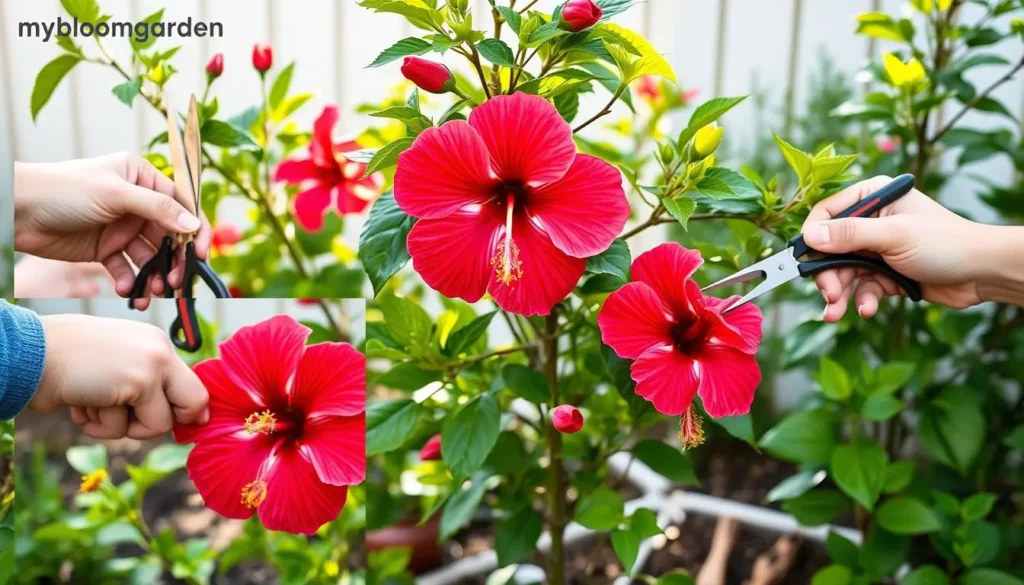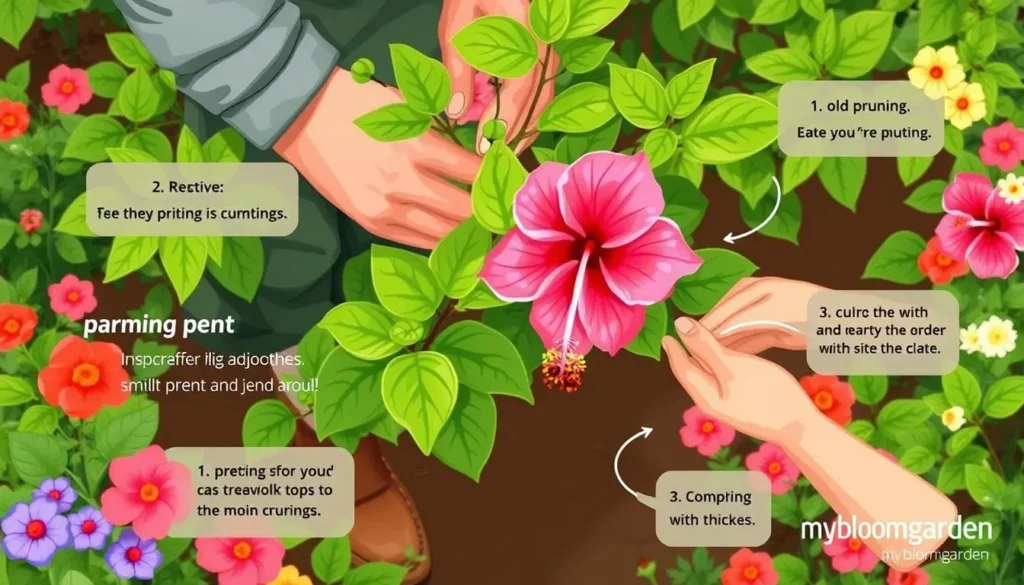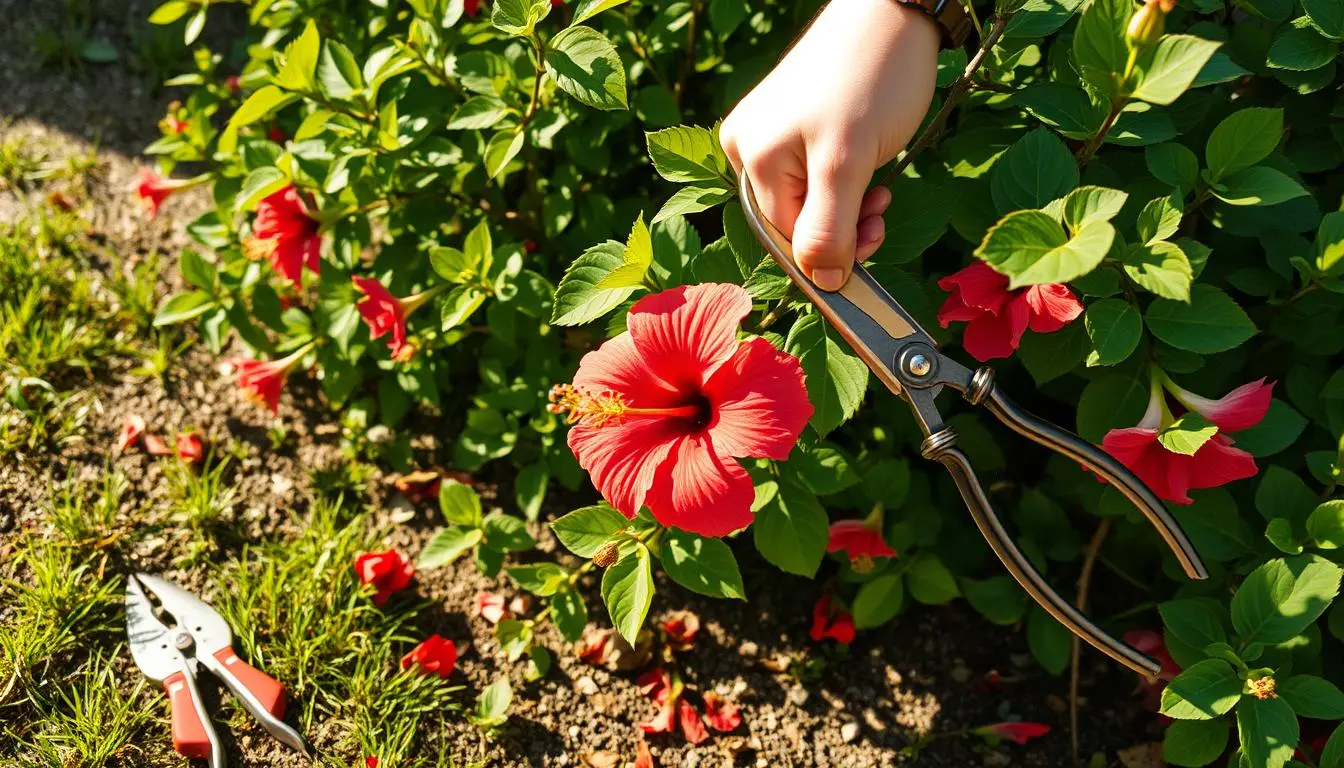As I step into my garden, the vibrant blooms of the hibiscus plants captivate my senses. They fill the air with their enchanting fragrance. These tropical beauties have become a cherished part of my outdoor sanctuary.
Maintaining their health and vitality is a labor of love. Today, I’m excited to share with you a comprehensive guide on the art of pruning hibiscus plants. This practice can unlock their full potential and breathe new life into your garden oasis.
Whether you’re a seasoned gardener or just starting, this guide will equip you with the knowledge and confidence. You’ll learn to transform your hibiscus plants into thriving, vibrant masterpieces. We’ll explore the essential steps to ensure your hibiscus plants flourish with remarkable beauty and resilience.
Table of Contents
Understanding Your Hibiscus Plant’s Growth Pattern
Pruning your hibiscus plant needs a good understanding of its growth patterns. There are many types of hibiscus, each needing different care. The seasons also affect when and how to trim your plant.
Different Types of Hibiscus and Their Pruning Needs
Hibiscus plants fall into several categories, like tropical, hardy, and container-grown. Tropical hibiscus grow fast and need regular pruning. Hardy hibiscus grow slower and need less pruning. It’s key to know your hibiscus type for the right pruning.
Growth Cycles Throughout the Seasons
- Spring: This is the best time to prune hibiscus plants. It helps shape them and promotes new growth.
- Summer: Hibiscus plants bloom a lot in summer. Prune lightly to keep the blooms coming.
- Fall: Hibiscus plants slow down in fall, getting ready for winter. Pruning now helps them prepare.
- Winter: Hibiscus plants are dormant in winter. Prune very little to avoid damage from cold.
Knowing your hibiscus plant’s growth and seasonal needs helps you prune right. This keeps your plant healthy and blooming.
Essential Tools for Pruning Hibiscus Plants
Proper pruning is key for your hibiscus plants’ health and vibrant blooms. To trim hibiscus and cut back hibiscus well, you need the right tools. Let’s look at the essential equipment for your hibiscus pruning routine.
Pruning Shears
A reliable pair of pruning shears is the base of your toolkit. Find sharp, high-quality shears that can cut through thick stems without harming the foliage. Keep your shears sharp and well-maintained for the best results.
Loppers
Loppers are vital for cutting larger branches or tough parts of your hibiscus. They have longer handles and stronger blades, making it easy to trim back thick, woody parts. Choose loppers with comfortable grips and durable construction.
Sanitizing Solutions
Keeping your pruning tools clean is crucial to prevent disease spread. Use a solution of 1 part bleach to 9 parts water to sanitize your shears and loppers between cuts. This keeps your hibiscus plant healthy and disease-free.
With the right tools, you’ll be able to keep your hibiscus plants perfectly trimmed and cut back.
Best Time to Prune Hibiscus Plants
Timing is key when pruning hibiscus plants. Knowing the best seasons and conditions helps keep your hibiscus healthy and blooming. Let’s look at the best times to prune and some helpful tips.
Spring Pruning Guidelines
Spring is the best time for a hibiscus trim. As the weather gets warmer and new growth starts, it’s a great time to prune hibiscus in spring. Cut out dead, damaged, or crossing branches to improve air flow and sunlight.
Winter Preparation Tips
Before winter, it’s important to trim hibiscus tree. Cut back branches to a size you can handle, removing weak or unruly ones. This saves energy and reduces winter damage risk.
Emergency Pruning Situations
- Severe storm damage: If high winds or heavy snow damage your hibiscus, prune the affected areas right away.
- Pest or disease issues: Quickly remove diseased or infested branches to stop the problem from spreading.
- Unruly growth: If your hibiscus gets too big or invasive, prune it to keep it in shape.
Understanding the right time for pruning is crucial for hibiscus care. By following these guidelines, you can keep your hibiscus healthy and blooming all year.
How to Prune Hibiscus: Step-by-Step Instructions
Proper pruning is key for your hibiscus plants’ health and beauty. Follow these steps for a successful pruning. This will help your flowers grow well.
- Identify the right time to prune. The best time is in the spring, just before new growth starts.
- Gather the necessary tools. You’ll need sharp, clean pruning shears or scissors for clean cuts.
- Examine your hibiscus closely. Look for dead, damaged, or diseased branches to remove.
- Make clean, angled cuts. Cut at a 45-degree angle just above a leaf node or healthy bud when removing a branch.
- Shape your hibiscus. Prune to keep the plant’s shape and size as desired.
- Remove any suckers or water sprouts. These vertical shoots can take energy from the main growth.
- Disinfect your tools between cuts. This prevents plant diseases from spreading.
The key to successful hibiscus pruning is to make clean, precise cuts and remove only what is necessary. By following these steps, your hibiscus plants will stay healthy, full of vibrant blooms, and look their best.
“Pruning is an art form that requires patience and a keen eye. Take your time, and your hibiscus will thank you with stunning flowers.”

Prioritize Safety
Always wear gloves and eye protection when pruning to avoid injuries. Dispose of the pruned branches properly and wash your hands thoroughly after completing the task.
Identifying Which Branches to Cut
Pruning your hibiscus plant is key to keeping it healthy and blooming brightly. But, how do you know which branches to trim? Let’s explore the main ways to check your hibiscus and make smart cuts.
Dead and Diseased Branch Recognition
Start by looking closely at your hibiscus for dead or diseased branches. These will look dry, discolored, or damaged. Cutting back hibiscus branches that can’t be saved is vital. It stops disease from spreading and keeps your plant healthy.
Shape Management Techniques
When trim hibiscus, you also need to shape your plant right. Look for branches that are growing the wrong way or making your plant look unbalanced. Pruning these can help your hibiscus look neat and attractive.
Growth Direction Assessment
- Check how new growth is going on your hibiscus.
- Find branches that are growing inward or crossing others.
- Prune these to help your plant grow outward and evenly.
By carefully checking your hibiscus and making smart pruning choices, you can keep your plant healthy, vibrant, and looking great.
“Proper pruning is essential for the long-term health and appearance of your hibiscus plant.”
Cutting Back Hibiscus for Winter Protection
As winter approaches, it’s important to get your hibiscus plants ready. Cutting them back for winter helps them survive and grow well next year.
Hibiscus plants love warm, humid weather. But when it gets cold, they can get damaged by frost and wind. Cutting them back before winter protects them from these dangers.
Timing is Key
The best time to prune your hibiscus is in late fall or early winter. This lets them get ready for the cold. Try to prune 4-6 weeks before the first frost in your area.
Cutting Back Techniques
- Prune your hibiscus by cutting stems back to 6-12 inches above the ground.
- Take out any dead, damaged, or sick branches to help new growth in spring.
- Don’t cut the plant too short, as this can harm it in the cold.
After pruning, cover the base of the plant with mulch. This keeps the roots warm and safe from winter’s harshness.
“Proper winter preparation is key to ensuring your hibiscus plants thrive for years to come.”
By pruning your hibiscus before winter, you’re helping them succeed next year. Follow these steps, and you’ll enjoy beautiful hibiscus blooms for years.
Post-Pruning Care and Maintenance
After pruning your hibiscus plants, it’s important to take good care of them. A smart fertilization plan and adjusting your watering can help your hibiscus grow well. This way, it will bloom beautifully.
Fertilization Schedule
Give your pruned hibiscus a balanced, slow-release fertilizer. Follow the instructions on the fertilizer package, usually every 4-6 weeks when it’s growing. This helps your plant grow strong leaves and flowers.
Watering Adjustments
Keep an eye on how much water your hibiscus needs after pruning. Water it less often to help it heal and grow new leaves. Water your hibiscus when the top inch of soil feels dry. Make sure the soil doesn’t get too wet.
By taking care of your hibiscus plants after pruning, they will recover fast. With the right food and water, your hibiscus will look healthy and bloom beautifully. You’ll enjoy seeing your hibiscus flowers grow in the future.
Common Pruning Mistakes to Avoid
Pruning your hibiscus plants can be rewarding, but it’s key to avoid common mistakes. These mistakes can harm their health and growth. By knowing the best practices, your hibiscus plants will thrive and bloom abundantly. Let’s look at some common pitfalls to avoid when pruning hibiscus.
- Cutting at the Wrong Time: Timing is crucial when it comes to how to prune hibiscus. Avoid pruning during the plant’s dormant season or when it’s under stress. This can stunt growth and delay flowering.
- Improper Cutting Techniques: Make sure your pruning cuts are clean and at the right angle. Jagged or uneven cuts can make the plant vulnerable to disease and pests.
- Over-Pruning: While regular pruning is key, be careful not to remove too much foliage at once. This can shock the plant and stunt its development.
- Neglecting to Disinfect Tools: Always disinfect your pruning tools before and after use. This prevents the spread of diseases and pests. This simple step can greatly improve your hibiscus plant’s health.
By avoiding these common mistakes and following best pruning practices, you’ll keep your hibiscus plants healthy and vibrant. They will reward you with plenty of blooms season after season.

“Proper pruning is essential for the long-term health and appearance of your hibiscus plants.”
Promoting Healthy Blooms Through Strategic Pruning
Learning how to prune hibiscus plants is key to a stunning garden. Mastering pruning techniques helps your hibiscus thrive. It will produce lots of healthy, vibrant blooms.
Deadheading Techniques
Deadheading is vital for continuous blooms on your hibiscus. It means removing spent flowers. This makes the plant focus on new buds and flowers, not old ones.
To deadhead, cut off the spent flowers at the stem. Do this just above the nearest healthy leaves.
Bud Development Optimization
Strategic pruning also boosts bud development. By removing some stems and branches, you help the plant grow bigger flower buds. This leads to more impressive and longer blooms.
Stay in touch with your hibiscus plant’s growth. Tailor your pruning to fit its needs. With practice and the right techniques, your garden will bloom beautifully.
“Proper pruning is the secret to unlocking the full potential of your hibiscus plants.”
Conclusion
Pruning your hibiscus plants is key to keeping them healthy and looking great. Knowing how different hibiscus types grow helps a lot. Using the right tools and pruning at the right time ensures your plants flourish.
Spring, winter, or emergencies, this guide has you covered. It shows you how to pick the right branches to cut. Avoiding common mistakes and trimming for healthy blooms will make your hibiscus plants stunning.
Your hibiscus plants’ health and look depend on how you prune them. By following this guide, you’ll keep your plants vibrant and beautiful. Enjoy your gardening journey!

